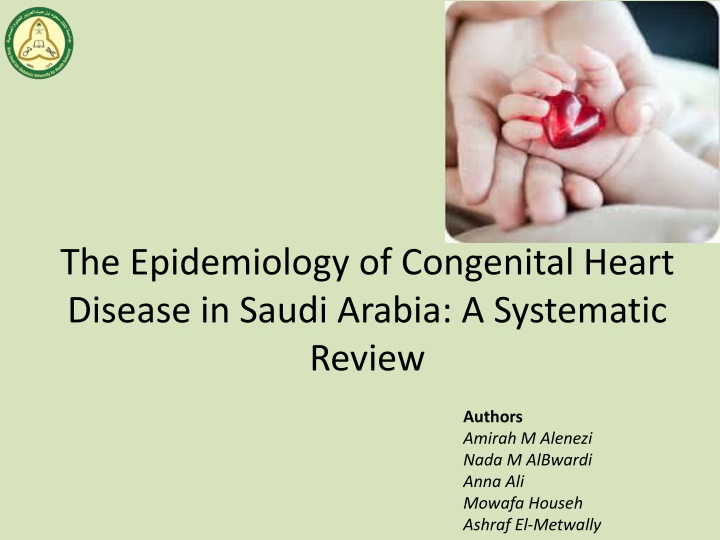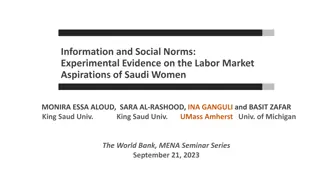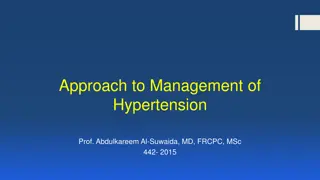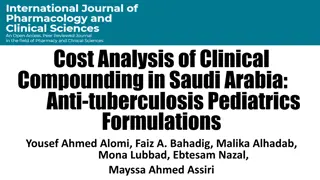
Epidemiology of Congenital Heart Disease in Saudi Arabia: A Comprehensive Review
Explore the epidemiology of Congenital Heart Disease (CHD) in Saudi Arabia through a systematic review, covering incidence, prevalence, impacts, and public health initiatives. Gain insights into the burden of CHD in the Kingdom for future healthcare strategies.
Download Presentation

Please find below an Image/Link to download the presentation.
The content on the website is provided AS IS for your information and personal use only. It may not be sold, licensed, or shared on other websites without obtaining consent from the author. If you encounter any issues during the download, it is possible that the publisher has removed the file from their server.
You are allowed to download the files provided on this website for personal or commercial use, subject to the condition that they are used lawfully. All files are the property of their respective owners.
The content on the website is provided AS IS for your information and personal use only. It may not be sold, licensed, or shared on other websites without obtaining consent from the author.
E N D
Presentation Transcript
The Epidemiology of Congenital Heart Disease in Saudi Arabia: A Systematic Review Authors Amirah M Alenezi Nada M AlBwardi Anna Ali Mowafa Househ Ashraf El-Metwally
Presenter: Ashraf El-Metwally Assistant professor of Epidemiology, Collage of Public Health and Health Informatics, King Saud bin Abdulaziz University for Health Sciences, Riyadh, Saudi Arabia
Background CHD CHD : A gross structural abnormality of the heart or intra-thoracic great vessels that is actually or potentially of functional significance (Mitchell SC et al, 1971) Range of defects varies from a single simple defect with no symptoms to multiple complex of defects with several symptoms. (Bernier PL et al, 2010) Minor heart defects may not affect the quality of life of the patient. (Koshnood B et al, 2010 van der Bom T et al, 2012) Severe heart defects would require extensive medical support. (Koshnood B et al, 2010 van der Bom T et al, 2012) 3
Background Etiology Etiology is not known, but CHD is linked with either genetic or environmental predisposition. (Blue GM et al, 2012) Down s syndrome and consanguinity are more frequently associated with CHD. (Blue GM et al, 2012) Evidence for the contribution of specific environmental factors to CHD causation is limited. (Blue GM et al, 2012) Folic acid supplementation in the preconception period, ensuring rubella vaccination has been completed before pregnancy, and maintaining good glycemic control in mothers with diabetes may reduce the risk of CHD in infants. (Blue GM et al, 2012) 4
Background Global Burden Wide variation in the incidence of CHD varying from 4/1000 to 50/1000 live births. (Hoffman JIE et al, 2004) International studies have reported prevalence ranging from 10- 119 per 10,000 persons. (Dolk et al, 2010 Koshnood et al, 2012 Marelli et al, 2007 van der Bom T et al, 2012) Variation is primarily due to the use of different methods to diagnose CHD. (Hoffman JIE et al, 2004) The relative frequency of different major forms of CHD also differs greatly between studies. (Hoffman JIE et al, 2004) The total incidence of CHD is dependent on the relative frequency of VSDs, the most common type of CHD. (Hoffman JIE et al, 2004) 5
Aims Aims No recent systematic review has examined the growing scientific evidence with respect to the epidemiology of CHD in the Kingdom To provide a comprehensive summary of CHD Burden Incidence Prevalence Impact To better understand the disease's magnitude Aid in future public health initiatives in Saudi Arabia 6
Methods An electronic search was conducted in January 2014 PubMed and Google Scholar Supplementary search for articles: Cross-referencing and Reviewing locally published journals 7
Methods Keywords Inclusion Criteria Written in English Published up to 2013 Heart Cardiac Congenital Defect Epidemiology Prevalence Incidence Risk Impact Saudi Arabia Exclusion Criteria Treatment or Interventional studies 8
Flow Chart Articles Founded in Pub-Med On Advanced Search Total=108 Disease Non-Relevant Topics Treatments/Interventions Total=48 Total=39 Relevant Disease Topic Full Text Abstract Total=18 Total=3 Total=21 Articles Used in the Current Review Total=21 9 Figure1: Flow Chart of the Literature Review Search.
Results Prevalence Studies Greer W et al in 2005: Southwestern region had the highest burden of CHD with prevalence of 7.48 cases/ 1000 persons, Central region (2.7), Northern region (2.5) Alqurashi et al in 2004-05: Prevalence of CHD in children and adolescents was 2.1 cases /1000 persons Alnajjar et al in 2009: Reported 2,047 new cases of CHD, 34% of all cardiac cases in Al Madina Almawazini and Al Ghamdi in 2011: 26.8% of all cardiac patients were diagnosed with CHD in Southern Western Saudi Al-Mesned et al in 2012: Incidence of severe CHD was 5.4 per 1,000 live birth/year 10
Results Prevalence Studies Most common type of defect reported by studies was VSD Jaiyesimi et al in 1993: Among prospective cohort of 320 patients 38.5% had VSD Bhat et al in 1997: Among 1209 children referred to the cardiology clinic 29.7% had VSD Abbag F et al in 1998: Among 608 CHD cases 32.5% had VSD Alabdulgader et al in 2001 : Among 740 CHD cases 39.5% had VSD ASD (8.9% to 18.1%) and PS (6% to 12.4%) 11
Results Risk Factor Studies Risk factors that were highlighted in different studies include: Down Syndrome Consanguineous marriage Diabetic mothers Social Impact 12
Results Risk Factor Studies Down Syndrome(DS) Jaiyesimi et al in 1993: Among 320 cases of CHD, trisomy-21 was found in 10%. Alabdulgader et al in 2001: DS was found in 6% of all patients. Al-Jarallah et al in 2009: Among 110 down syndrome 49% had CHD. Aama et al in 2012: 130 patients with DS, CHD in 86.8% Abbag et al in 2006: CHDs was found in 61.3% with DS. 13
Results Risk Factor Studies Consanguineous Marriage Becker and AlHalees in 1999: First cousin marriages in 41.6% of children with CHD, compared to only 28.4% in general public. Seliem et al in 2007: 62 % of CHD children were product of first cousin marriages El Mouzan et al in 2008: 56% of children with CHD were product of consanguineous marriages and CHD to be the only statistically significant disease associated with first cousin consanguinity 14
Results Risk Factor Studies Maternal Diabetes Abu-Sulaiman et al in 2004: CHD among children of 100 diabetic mothers was determined to be higher than in the general public; 15/1,000 live births Social Impact Almesne et al 2013: Families of children with complex CHD had significantly higher IFS score, 62 vs. 51 (P=0.005) 15
Discussion 1 Cross-sectional studies found the prevalence of CHD ranging between 2.1 to 10.7/ 1,000 persons 2 The most prevalent type : VSD ranging from 29.5% to 39.5% of all diagnosed CHDs, followed by ASD (8.9% to 18.1%) and PS (6% to 12.4%) 3 Incidence of severe CHD : 5.4/1,000 live births per year 4 Occurrence of CHD in Saudi Arabia: Significantly associated with Down s syndrome, consanguinity and maternal diabetes 16
Limitations 1 2 Limiting our search for articles in English Publication bias 4 3 Limitations of the individual studies Very few follow-up studies 17
Comparison with Other Studies International studies have reported prevalence rates ranging from 1-11.9 per 1000 persons. (Dolk et al, 2010 Koshnood et al, 2012 Marelli et al, 2007 van der Bom T et al, 2012). In KSA ranges from 2.1- 10.7 per 1000 persons Common cardiac congenital lesion reported in KSA was VSD ranging from 29.5% to 39.5%which is consistent with other parts of the world.(Hoffman et al, 2004Koshnood et al, 2012 Rose et al, 1964) The 2nd most common type of CHD in KSA, ASD, was also 2nd most frequent in incidence studies in the US, Canada and Bohemia while other studies found it to be less common; the 4th most common form in Hungary at 10.4%and the 5th most common type in Sweden at 4.3%.(Carlgren 1959 M sz ros et al, 1975Mitchell et al 1971, Sam nek et al, 1989) 18
Comparison with Other Studies Presence of CHD in children with Down's syndrome ranged from 40% to 55% in international studies same as reported in KSA. (de Rubens et al, 2003 Roizen et al, 2014Vida et al, 2005 Wells et al 1994) In KSA first cousin marriage was significantly associated with VSD, ASD, AVSD, PS, and PA. Similarly, septal defects (VSD and ASD) were consistently found to be associated with consanguinity especially at first cousin level, in several international studies. (Al Husain et al, 1997) 19
Conclusion and Recommendations 1 General understanding of the CHD epidemiology in Saudi Arabia 2 CHD have prevalence higher than that in Western countries and comparable to those reported in other developing countries 3 Consanguineous marriages, maternal age, Diabetes and Down syndrome were among risk factors related to CHD 4 Identified risk factors are potentially modifiable, emphasizing the importance of public health programs 5 Studies that explored the prognosis and burden of these diseases on the Saudi society and healthcare services are scarce and should be the focus for future research 20
Thank You For Your Attention 21






















